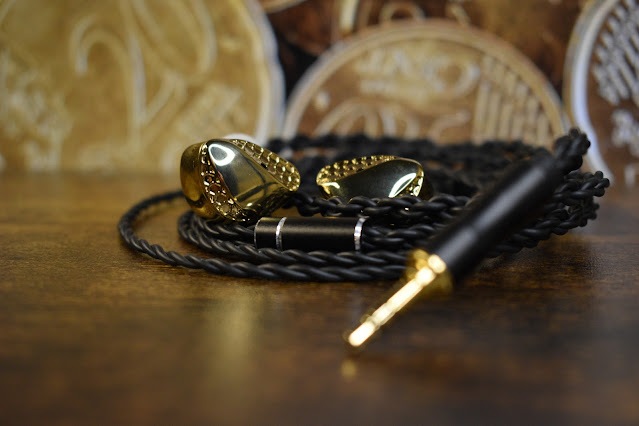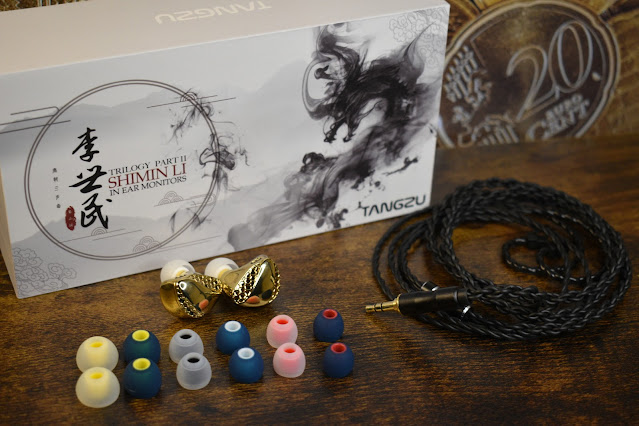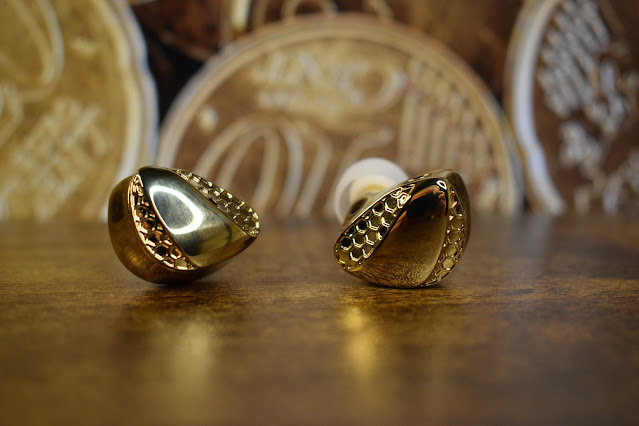- Get link
- X
- Other Apps
English | Español
Also available on YouTube in Spanish: Acho Reviews YouTube
The Tangzu Shimin Li have been sent to me by HifiGo in exchange for the publication of this review. HifiGo have not made any specific requests or comments, therefore, as usual, I will attempt to be as unbiased as possible in my review but you should always consider the fact that these IEMs have not cost me anything.
As always, I will leave a non-afiliate link to the Shimin Li via HifiGo below, as I feel it is the least I can do when somebody is kind enough to send a product in for review.
The Tangzu Shimin Li can be found via Hifigo here: https://hifigo.com/products/tangzu-shimin-li
Intro…
In the later part of last year, I reviewed a set of IEMs called Yuan Li, by a company called T-Force. I really enjoyed those IEMs and still do, being one of my favourite sets around 100€ and actually getting more ear time than many other sets that I have reviewed. In fact, they still live in my case of 6 pairs of IEMs that are available to quick grab and I also use them for comparisons a fair bit.
Why am I mentioning the Yuan Li? Well, the Yuan Li was called “Trilogy Part I”, something that was shown quite clearly on the box. Fast forward som 9 months and here we are with the “Trilogy Part II”, although it is a little confusing I must say, as the brand has now changed from T-Force to Tangzu, the price has dropped from just over 100€ to just over 30€ and the whole package is quite a bit different.
When something is from the same series, specifically called a trilogy, then it is only normal that comparisons be drawn between them. However, in this case, while I still want to compare them, and will be doing so, it is difficult to do a direct comparison when they are in such vastly different brackets.
Anyhow, let’s take a look at the Shimin Li on its own merits as see what they offer in this ultra-budget IEM category.
Presentation…
It is no surprise that the presentation of the Shimin Li has been cut down when the overall package has had such a price cut but that doesn’t mean that it is bad, it is still good for its new price bracket.
Inside a box that is quite reminiscent of the Yuan Li, with traditional chinese artwork decorating the exterior, we find the IEMs, a cable, and quite a large selection of tips (7 pairs in total).
Ok, there is no carrying case and a lot of the additional paperwork has been reduced, but honestly, I have absolutely no issue with the contents. As I always say with IEMs in this price bracket, I would rather them spend the money on the IEMs themselves than a bunch of accessories that I may or may not (probably not) use.
Build and accessories…
The aesthetics of the Shimin Li have also changed a lot in comparison to part 1 of the trilogy. My understanding is that they are available in both gold and silver, with me having received the gold version.
Personally I am not a fan of gold coloured anything to be honest, it is just something that I don’t like, which is unlucky for the Shimin Li as there are probably people out there that love it. The finish is a mirrored gold which does attract a lot of fingerprints and I can imagine being quite delicate if you don’t place the IEMs correctly when transporting them.
The shape of the IEMs is actually quite unique and I must say that I don’t dislike the shape, I find it very comfortable and the overall look with the honeycomb style part is a nice original touch. I think that if they were in another colour, I would probably be saying how great they look, whereas gold (to me) makes them look cheaper rather than more expensive.
As far as build quality, they are all metal and seem to be well assembled. As with anything, only time will tell if this is the case or not but at first glance, I don’t see any build issues. The only thing that I see as being a possible issue is the mirrored finish that I already mentioned.
The included cable is also a little unique, I don’t remember having had a cable quite like it. It is sort of a matte rubbery plastic finish, which is nicely woven and has decent hardware at the TRS end, although the IEM end does have plastic connectors that don’t really scream quality. The connections are 2 pin, which I like, and although at first look and touch of the cable, I wouldn’t say I loved it, it is actually not a bad cable. It doesn’t tangle too much, it is not too thick or thin (in my opinion of course) and all in all it does its job without causing any issues.
Sound…
Let me preface this by saying that I tried the included tips but in the end opted for Spring tips as I found they balanced the sound better and gave me a better seal and fit. As tips are very personal, you may find that a set of the included stock tips work better for you but my following opinions are based on using the Spring tips (powered by the iFi Gryphon as usual).
Although this is not exactly an updated version of anything, like a fair few of the the IEMs I have reviewed lately, it is the second in a series so I think that a comparison graph is in order between the Yuan Li and the Shimin Li. That and the fact that it is quite interesting to see how similarly these measure:
(all my measurements can be found and compared on achoreviews.squig.link)
As you can see, the tuning is very similar between the two and although they are slightly different, they are very reminiscent of each other. However, since I took this measurement, I was discussing it with a couple of other reviewers and it seems that my measurement of the Yuan Li does not match the retail version of those IEMs. In fact, the measurement matches what was originally a pre-release version of the Yuan Li, which was later modified when released for retail.
Now, the Yuan Li I received was not a pre-release model, it was sent to me by a store that had them in stock months after the official release. Therefore, I have no idea why I may have received a version with that tuning but that is what I have (and I like it) and wanted to include this in this review. I will actually go back and add a note to the original Yuan Li also with this info.
The main thing that this affects is that when I am comparing the new Shimin Li to the Yuan Li, I am actually comparing it to the Yuan Li that I have, which is not necessarily the Yuan Li you will find on sale.
But anyways, back to the review…
Starting off with the subbass, there is enough to make me happy. These are not IEMs that are really focused in the subbass area, they don’t rumble and produce a huge amount of subbass, but they don’t sound rolled off or anaemic either. My usual “Chameleon” test comes across with a nice amount of subbass and while it is maybe not a “wow” experience like it is on many other sets, I don’t have any complaints.
Moving into the midbass zone, there is a little more emphasis here than in the subbass category but again, it doesn’t come across as being overdone. There is enough midbass to enjoy a little extra warmth in the low end but at the same time, it doesn’t place too much of the focus on these lower notes. With tracks like “No Sanctuary Here”, the low notes are present enough to be impressive whereas with things like “Give Me One Reason”, there is not too much as to make the electric guitar seem bloated in the low ranges.
In fact, the whole low end of the Shimin Li is very very similar to the low end of the Yuan Li, which I believe to be the same on both tunings of the Yuan Li, something that I really don’t have much to complain about.
Moving into the mids, there is a slight recess in the middle of these frequencies but the presence around 2kHz does its job of bringing back the presence of vocals and other instruments in the higher mids.
I do feel that the additional presence in this 2kHz area is a little overdone, making it come across a little harsher in these frequencies than I would prefer but it is not too bad and it does do a good job of counterattacking that extra presence in the mid bass. I find that female voices especially show this extra presence, even more so when they are already a little harsh themselves, such as Beth in “Don’t You Worry Child” or Alicia Keys in “No One (Acoustic)”. The higher mids of female vocals are really what I would claim to be the weaker point of the Shimin Li tuning.
In addition to this 2kKz presence, there is another peak slightly higher up in the spectrum but it is actually not as high, or as present, as on the Yuan Li that I have. This means that the Shimin Li avoids the dreaded 5kHz peak that I fear so much, but at the same time, it does add even more to the sensation of the 2kHz being just a little too hot.
Moving into the treble areas, it does seem to roll off quite early, which leaves the sensation of a lack of air and breathing space, but at the same time, this does avoid sibilance quite well. I would like it to extend a bit more in these upper ranges, having a little more openness, but to be fair, the vast majority of budget single dynamic driver IEMs suffer from the same thing in these regions. The ones that don’t are more of an exception than a regular occurance.
One thing that I do find to be quite a step down in comparison to their previous model is the soundstage. I actually found the Yuan Li to be a little above average in this regard, whereas the Shimin Li is a lot less spread out. It is not terrible but things are a lot closer on this new model, with image placement that is acceptable but by no means spectacular.
Finally, details. As with soundstage, I feel that the Shimin Li is not quite up to the performance of part 1, or at least the part 1 that I have here. I would not say that these IEMs are a set that will impress those looking for appreciation of the minute details of recordings. With the reduced soundstage and a reduction in the reproduction of the smaller details, songs like “Strange Fruit” can become a little one dimensional, taking away from the experience of these kinds of recordings. Even with more separated recordings, such as “La Luna”, you just don’t get the sensation of the instruments surrounding you like you do on other sets.
Conclusion…
There is a common saying that second parts are never good, and while I don’t agree totally, I do agree that in this case, the second part is not as good as the first. It is possible that I personally expected more due to how much I enjoy the first part of the trilogy, meaning that I was already starting with an expectation bias that wouldn’t have been the case if it was an IEM that I had never heard of.
However, while this second chapter may not be as good as the first, or at least not the first chapter that I enjoy, they have done something that I feel makes this a lot better, which is drop the price. If they had kept the price around the same as the original, then I would certainly say skip this but as they have reduced the price by almost 75%, they deserve to be recognized for they have done, and that is put out an extreme budget set of IEMs with some things that it does very well.
I know I said that the aesthetics are not my thing, but that is just as personal as the fit (which is very comfortable for me by the way), so that is something that people don’t really need a reviewer to comment on, although I do it anyway ;)
That leaves the sound and to be fair, I do enjoy this tuning. Yes it is a little hot around 2kHz but I much prefer that than a 5kHz peak and in general, the tuning is very similar to the Yuan Li I have in my possession, a set of IEMs that I really like.
There is a lack of detail and soundstage in comparison to the Yuan Li, but again, it is not really a fair comparison when looking at the price brackets. If we compare it to other sets around the same price, yes there are some that are subjectively better, but there are also a lot that are subjectively worse.
I’m looking forward to finding out what they will surprise us with in the third part of the trilogy.
All FR measurements of IEMs can be viewed and compared on achoreviews.squig.link
All isolation measurements of IEMs can be found on achoreviews.squig.link/isolation
To comment or contact, visit any of the following social media platforms:





.png)

